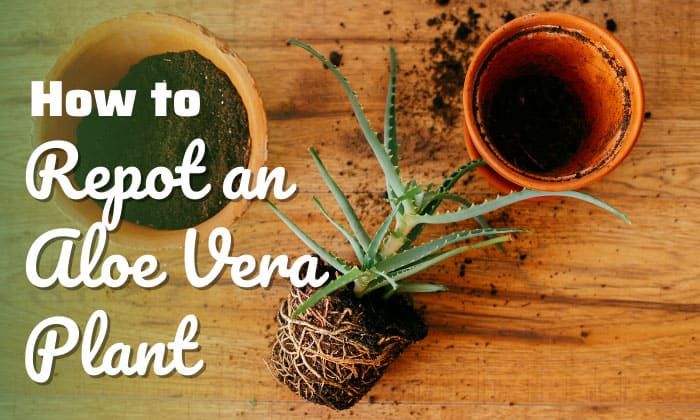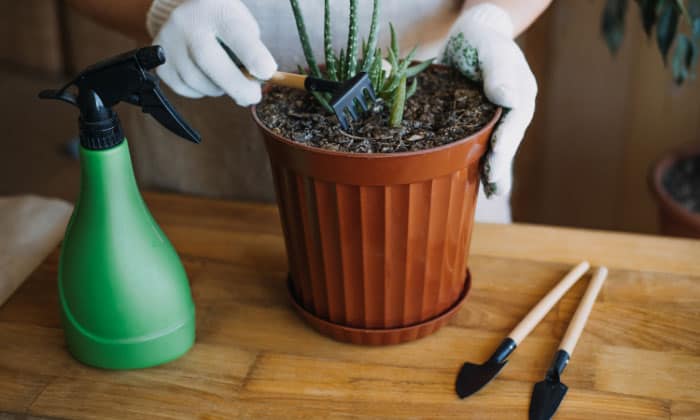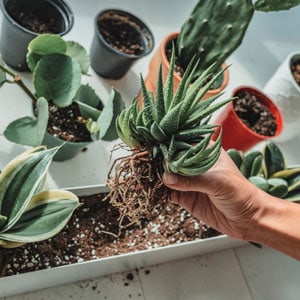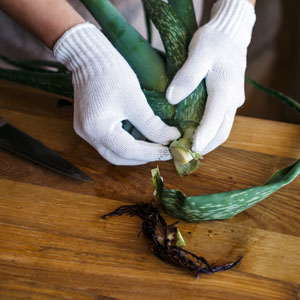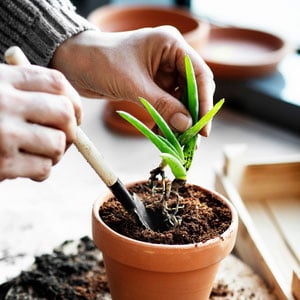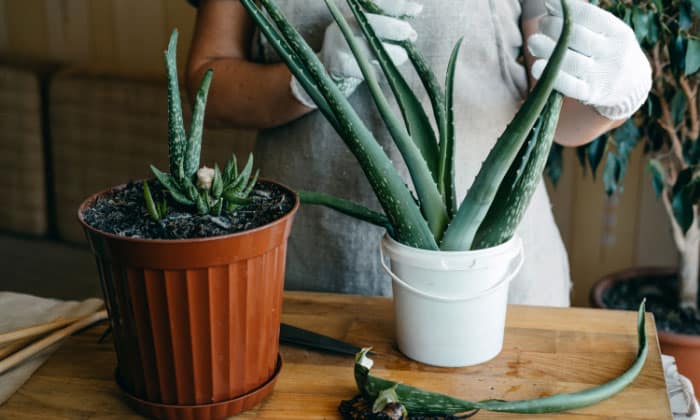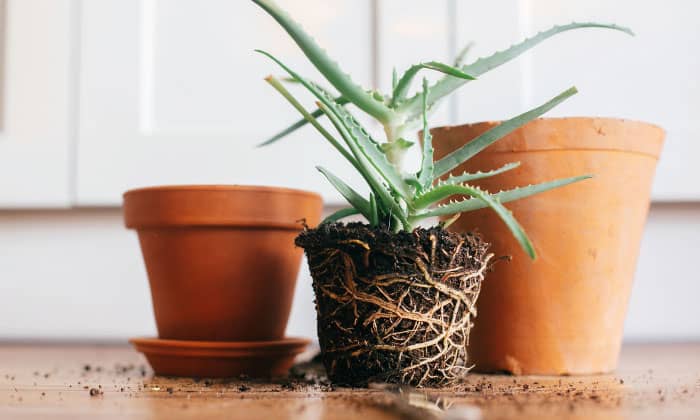Do aloe plants like to be root bound? No. They enjoy a little constriction but do not thrive in this state because eventually, the roots will have problems absorbing nutrients, leading to stagnant growth and dead foliage.
In this case, knowing how to repot an aloe vera plant will give it a new lease on life. Read below as we’ll tell you how to do just that.
Table of Contents
Step to Repot an Aloe Vera Plant
Tools Needed
- Aloe potting soil
Opt for cactus or succulent soil, which is well-drained enough for aloe vera.
You may also create your potting medium by combining equal parts of compost and shredded leaves with twice as much pumice.
Avoid clay, silt, or vermiculite particles, which can affect the porosity of your plant mix. Regular potting soil is also suboptimal, since it will decline and need replacing more quickly.
- Aloe vera planter
Since aloe need drainage, we recommend you find pots with at least one drain hole at the bottom. Terracotta, ceramic, and concrete will make for good materials, as will plastic, wood, or metal, but note that terracotta and ceramic will be pretty heavy. In addition, porous materials are generally a better choice, as they promote drainage.
It’s convenient to find containers with a saucer as well, but if you can’t acquire one, just use any regular tray around your home to catch water drips.
Last but not least, the size pot for aloe plant should be one to two inches wider than the current container or 5 to 10% bigger than the aloe.
- Scissors or pruner
- Rubbing alcohol (70% or higher concentration)
- Fungicide (if your plant has root rot)
- Trowel
Now that you know what soil and pots for aloe plants are best, pay attention to the steps below.
Step 1. Remove the overgrown aloe from its pot.
A day before repotting, water the aloe to minimize transplant shock. If your plant has overwatering issues, skip this phase.
The next day, gently loosen the soil with your trowel and lift the aloe vera from its position. Place the container on its side, and shake or squeeze it as necessary.
Step 2. Remove dead, diseased leaves and root rot.
Brush off old dirt on the aloe plant and trim away all sick or dead roots that look mushy and fragile. Pluck off brown or yellow leaves while you’re at it.
Just as importantly, make sure you sanitize your pruner with rubbing alcohol between cuts and apply fungicide on the trimmed areas.
Step 3. Put the aloe plant in pot.
Run the pot under water to wash off any impurities, then fill the bottom third of your new container with the aloe vera potting mix. Make a hole in the mix with your hand or trowel, then put the plant in it before backfilling the container.
There should be at least a three-quarter inch space between the houseplant mix and the pot rim, so water won’t flow out before it can sink in. Do not cover or submerge the leaves with soil—you don’t want water to get on them and lead to rust.
When to Repot Aloe
If you’re unsure whether it’s time to repot aloe, consider whether the following applies to your situation:
- You have a top heavy aloe plant that keeps falling.
- The roots are forming circles at the bottom of the pot.
- There are pups (small offshoots) on the aloe, and they are big enough to reach the container sides.
- The potting mix is old, not well-drained, or nourishing enough.
- Plant roots are coming out of the drain holes or cracking the container.
- The crown or leaves are sick despite proper care.
- Legginess or droopy leaves are cause for concern as well, particularly if you’ve ruled out all other factors like watering and sunlight.
- The aloe fails to grow or has root rot.
- It’s been two to five years since the last container change.
In any case, repot your aloe in spring or summer, unless the plant is highly sick and requires a new environment immediately.
Tips to Replant Aloe Vera
1. Watering after repotting is discouraged.
Wait a week and let the plant adapt before resuming irrigation. Let the top two inches of the soil dry before watering. Usually, an irrigation rate of once every two weeks will do in spring and summer, while fall and winter will require watering every four weeks.
2. To repot aloe vera that has developed a long stem
Find a pot as deep as the stem is long. Fill the pot with manure and bury the stem in it, but not before removing the bottom leaves first.
Alternatively, you may cut off the stem and replant it separately. Use disinfected scissors to make a clean trim, and let the removed stem dry and form a callus before transferring it to a new container. Similar to the previous method, do not bury the leaves when repotting aloe vera long stem.
3. If you have a large aloe plant and want to make it smaller, repot aloe pups.
Find these small offshoots at the base of the container, preferably those over four inches tall, and slice them off with a knife. Let the pups dry for two to three days before putting them in new pots with soil.
For this method, repotting aloe vera without roots is possible. The pups will regrow roots and become new plants, provided you put them in a sunny area with succulent soil and wait a week before watering.
4. Another way to propagate aloe vera is to repot aloe vera cuttings.
Simply remove leaf cuttings from the plant, then cut them down to 1.5 to 2 inches long. Fill your pot with cocopeat, put the cuttings into this plant medium, then water and cover the container with clear polyethylene.
Remove the plastic cover after 25 days. At this point, the cuttings should already form roots.
Note that using leaves is less effective than propagation using pups. So, split an aloe vera plant with offshoots if possible.
Caring for Aloe Vera After Repotting
After you pot an aloe plant, place it in a location with bright, indirect sunlight, such as next to a south-facing window.
For proper growth, a temperature of 55 to 80℉ is essential, and do not expose the plant to weather below 41 degrees. Suffice it to say, you should move your aloe indoors before extreme cold arrives, especially if you live somewhere with frost.
Finally, avoid fertilizing aloe a month after replanting and during winter.
If you see aloe leaves bending, that means the plant may lack sunlight, is getting too much or too little water, or the surroundings may be too cold for it. Other potential problems include fungal disease, bacterial rot, or a very shallow container.
Depending on the problem you have, make appropriate changes.
For example, use a fungicide for fungal infections and change the container if yours is too small. If you’re unsure how big of a pot for aloe vera to use, there should be one to two centimeters between the roots and all parts of the container.
As for bacterial soft rot, you may have no choice but to dispose of your succulent.
Conclusion
Knowing how to repot an aloe vera plant will help you care for it effectively. Simply prepare succulent soil for aloe vera plant indoors, an appropriate container size, and follow the steps above.
With the right level of sunlight and warm temperatures, your aloe should go back to thriving in no time.
Read more other gardening tips:

Hi, I am William – Floridayards’ digital content creator. My job is to find answers to all your concerns with thorough research and our team’s expert advice. I will also bring you honest reviews on the best products and equipment for raising your beautiful garden. Please look forward to our work!


